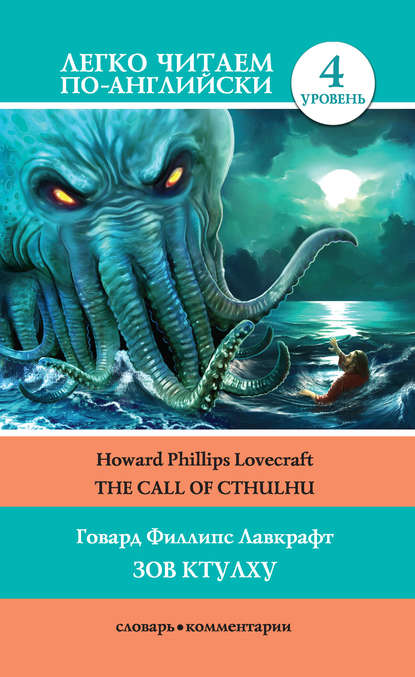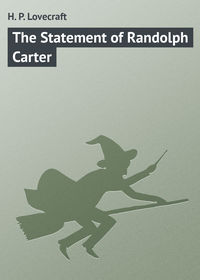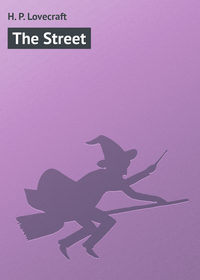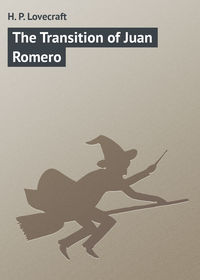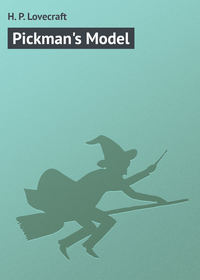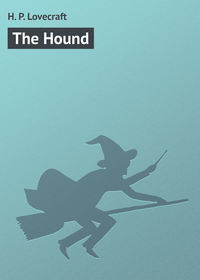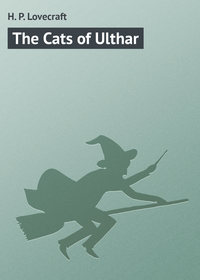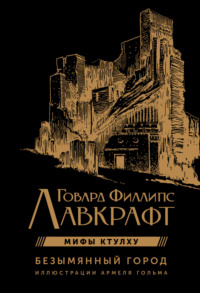
Полная версия
Зов Ктулху / The Call of Cthulhu. Уровень 2
The flabby claws swept three men up before anybody turned. They were Donovan, Guerrera, and Angstrom. Parker slipped as the other three were running to the boat. Johansen swears he was swallowed up by a masonry. When Briden and Johansen reached the boat, and pulled desperately for the Alert, the mountainous monstrosity flopped down the slimy stones and was floundering at the edge of the water.
Slowly, amidst the distorted horrors of that indescribable scene, the Alert began to sail. Then on the masonry of that shore great Cthulhu slid greasily into the water and began to pursue. Briden looked back and went mad. He was laughing till death found him one night in the cabin while Johansen was wandering deliriously.
But Johansen did not surrender. He knew that the Thing could surely overtake the Alert. So he set the engine for full speed, and reversed the wheel. The brave Norwegian drove his vessel head on against the pursuing jelly. The awful squid-head came to the bowsprit but Johansen drove on relentlessly.
There was a horrific bursting as of an exploding bladder, a stench as of a thousand opened graves. There was a sound that the chronicler could not put on paper. For an instant the ship was hidden by an acrid green cloud. And – God in heaven! The distance widened every second as the Alert gained impetus from its mounting steam.
That was all. After that Johansen only watched the idol in the cabin and prepared some food for himself and the laughing maniac. He did not try to navigate, for he was completely exhausted. Then came the storm of April 2nd. He lost his consciousness.
One day came rescue – the Vigilant, the vice-admiralty court, the streets of Dunedin, and the long voyage back home to the old house. He did not tell anything. Everybody would call him mad. He wrote of what he knew before death came. Death will be a boon if only it deletes the memories.
That was the document I read. Now I placed it in the tin box beside the bas-relief and the papers of Professor Angell. This record of mine will be placed with them. I do not think my life will be long. As my uncle went, as poor Johansen went, so I shall go. I know too much, and the cult still lives.
Cthulhu still lives, too, I suppose, again in that chasm of stone which shielded him since the sun was young. His accursed city is sunken once more. I know it because the Vigilant sailed over the spot after the April storm; but his ministers on earth still bellow and prance and slay around idol-capped monoliths in lonely places. Who knows the end? What rose may sink. What sank may rise. It waits and dreams in the deep, and decay spreads over the tottering cities of men. A time will come… – but I must not and cannot think about it! Let me pray that, if I do not survive this manuscript, my executors let nobody read this.
Howard Phillips Lovecraft
At the Mountains of Madness
I
I don’t want to tell the reasons why I oppose the invasion of the Antarctic – with its vast fossil hunt and its melting of the ancient ice caps. But I must do so. I can understand clearly that my story will seem extravagant and incredible. But there are photographs, both ordinary and aerial, and they will help me. They are vivid and graphic. Of course, some people can say that it is all fakery. And there are ink drawings, but somebody may laugh at them and call them obvious impostures.
I must rely on the judgment and standing of the few scientific leaders. They have, on the one hand, sufficient independence of thought. On the other hand, they have sufficient influence to deter the exploring world in general from any over-ambitious program[67] in the region of those mountains of madness. It is pity that[68] ordinary men like myself and my colleagues are connected only with a small university. That’s why we have little chance to make an impression in the controversial matters[69].
In the strictest sense, we are not specialists in these fields. Miskatonic University[70] sent me as a geologist. The aim of our expedition was to secure deep-level specimens of rock and soil from various parts of the Antarctic continent. We had a remarkable drill that was designed by Professor Frank H. Pabodie[71] of our engineering department. I hoped, as a geologist, that this new mechanical device will discover the materials, unacceptable by the ordinary methods of collection. And I had no wish to be a pioneer in any other field than this.
Pabodie’s drilling apparatus was unique and radical in its lightness, portability, and capacity. Only three sledges carried steel head, jointed rods[72], gasoline motor, collapsible wooden derrick[73], dynamiting paraphernalia[74], cords, rubbish-removal auger[75], and sectional piping for bores five inches wide and up to one thousand feet deep. This was possible due to aluminum alloy used by Pabodie. Four large aeroplanes were able to transport our entire expedition from a base at the edge of the great ice barrier to various inland points.
We planned to explore a great area in one season. We were operating mostly in the mountain ranges and on the plateau south of Ross Sea[76]. These were regions explored by Shackleton, Amundsen, Scott, and Byrd[77]. We expected to get a quite unprecedented amount of material – especially in the pre-Cambrian[78] strata. We wished also to obtain a variety of the upper fossiliferous rocks. The primal life history of this realm of ice and death is of the highest importance to our knowledge of the earth’s past. The Antarctic continent was once temperate and even tropical. We hoped to expand that information about its flora and fauna in variety, accuracy, and detail.
The public knows of the Miskatonic Expedition through our frequent reports to the Arkham Advertiser and Associated Press[79], and through the later articles of Pabodie and myself. There were four men from the University – Pabodie, Lake of the biology department[80], Atwood of the physics department[81] – also a meteorologist – and myself. I was representing geology and was a nominal leader. There were also sixteen assistants: seven graduate students from Miskatonic and nine skilled mechanics. Of these sixteen, twelve were qualified aeroplane pilots. Most of them were competent wireless operators as well. Eight of them understood navigation with compass and sextant, as did Pabodie, Atwood, and I. In addition, of course, our two ships were fully manned[82].
The Nathaniel Derby Pickman Foundation[83] financed the expedition. The dogs, sledges, machines, camp materials, and unassembled parts of our five planes were delivered in Boston. There our ships were loaded. We were marvelously well-equipped for our specific purposes. As the newspapers told, we sailed from Boston Harbor on September 2nd, 1930. We took a leisurely course down the coast and through the Panama Canal, and stopped at Samoa and Hobart, Tasmania [84]. There we got final supplies. Our ship captains were J. B. Douglas[85], commanding the brig Arkham, and Georg Thorfinnssen[86], commanding the Miskatonic. They both were veteran whalers in Antarctic waters.
At about 62° South Latitude we noticed our first icebergs. These were table-like objects with vertical sides. Just before reaching the Antarctic circle[87], which we crossed on October 20th with appropriately ceremonies, field ice [88] considerably troubled us. The falling temperature bothered me considerably after our long voyage through the tropics. Very often the curious atmospheric effects enchanted me vastly. Distant bergs became the battlements of unimaginable cosmic castles.
We were pushing through the ice. Finally, we regained open water at South Latitude 67°, East Longitude 175°. On the morning of October 26th, a snow-clad mountain chain appeared on the south. That was an outpost of the great unknown continent and its cryptic world of frozen death. These peaks were obviously the Admiralty Range discovered by Ross[89]. Our task was to round Cape Adare[90] and sail down the east coast of Victoria Land[91] to our base on the shore of McMurdo Sound[92], at the foot of the volcano Erebus in South Latitude 77° 9’.
The last part of the voyage was vivid and fancy-stirring. Great barren peaks of mystery, white snow, bluish ice and water lanes, and black bits of exposed granite slope. Something about the scene reminded me of the strange and disturbing Asian paintings of Nicholas Roerich[93], and of the disturbing descriptions of the evil plateau of Leng[94]. These descriptions appear in the dreaded Necronomicon of the mad Arab Abdul Alhazred[95]. I was rather sorry, later on, that I looked into that monstrous book at the college library.
On the 7th of November, we passed Franklin Island[96]. The next day the cones of Mts. Erebus and Terror on Ross Island[97] appeared, with the long line of the Parry Mountains[98] beyond. There was a white line of the great ice barrier. It was rising perpendicularly to a height of two hundred feet like the rocky cliffs of Quebec. It marked the end of southward navigation. In the afternoon we entered McMurdo Sound and stood off the coast near the Mt. Erebus. Beyond it rose the white, ghostlike height of Mt. Terror, ten thousand, nine hundred feet in altitude.
One of the graduate assistants – a brilliant young fellow named Danforth[99] – noticed lava on the snowy slope. On the barren shore, and on the lofty ice barrier in the background, myriads of grotesque penguins walked.
We used small boats and landed on Ross Island shortly after midnight on the morning of the 9th. Then we prepared to unload supplies. Our camp on the frozen shore below the volcano’s slope was only a provisional one. Headquarters were situated aboard the Arkham. We landed all our drilling apparatus, dogs, sledges, tents, provisions, gasoline tanks, experimental ice-melting outfit[100], cameras, both ordinary and aerial, aeroplane parts, and other accessories, including three small portable wireless devices – besides those in the planes. These devices helped us to communicate with the Arkham’s large device from any part of the Antarctic continent that we wanted to visit. The ship’s radio was communicating with the outside world. It was able to convey press reports to the Arkham Advertiser’s powerful wireless station on Kingsport Head, Massachusetts[101]. We hoped to complete our work during an Antarctic summer. Otherwise we planned to winter on the Arkham and send the Miskatonic north for another summer’s supplies.
I need not repeat what the newspapers already published about our early work. The health of our party – twenty men and fifty-five Alaskan sledge dogs – was remarkable. Of course we did not encounter really destructive temperatures or windstorms.
We reached Beardmore Glacier[102], the largest valley glacier in the world. The frozen sea changed to a mountainous coast line. We were eight thousand, five hundred feet above sea-level. When experimental drillings revealed solid ground only twelve feet down through the snow and ice at certain points, we made considerable use of the small melting apparatus.
In certain sandstones we found some highly interesting fossil fragments. We found ferns, seaweeds, and mollusks. They were very important for the region’s primordial history. There was also a queer triangular, striated marking[103], about a foot in greatest diameter. Lake, as a biologist, found these curious marking unusually puzzling and provocative. To my geological eye it looked not unlike some of the ripple effects common in the sedimentary rocks[104]. Since slate is no more than a metamorphic formation, I saw no reason for extreme wonder.
On January 6th, 1931, Lake, Pabodie, Danforth, the other six students, and myself flew directly over the South pole in two planes. There was a high wind. This was, as the papers said, one of several observation flights. Distant mountains floated in the sky as enchanted cities. Often the whole white world dissolved into a gold, silver, and scarlet land of dreams under the magic of the low midnight sun.
We resolved to carry out our original plan. We wanted to fly five hundred miles eastward and establish a new base. Our health remained excellent. It was now midsummer. With haste and care we will be able to conclude work by March and avoid a tedious wintering through the long Antarctic night. There were some severe windstorms but we escaped the damage. No doubt, we had our good luck. But this good luck was almost strange.
Lake insisted on a westward – or rather, northwestward – trip before our shift to the new base. He was too much interested in that triangular marking in the slate. He was strangely convinced that the marking was the print of some bulky, unknown, and unclassifiable organism of advanced evolution. Lake thought that this rock was probably Cambrian or even pre-Cambrian. It meant that this advanced organism existed in times when there was only unicellular life[105]. So these fragments, with their odd marking, were five hundred million – a thousand million years old.
II
The journey of January 11th to 18th with Pabodie and five others brought up more and more of the Archaean slate[106]. Even I was interested in evident fossil markings in that unbelievably ancient stratum. These markings, however, were of very primitive life forms. Therefore I did not like Lake’s idea to explore further. However I did not say no to his idea. But I decided not to accompany the northwestward party despite Lake’s plea for my geological advice. While they were gone, I remained at the base with Pabodie and five men. We were working out final plans for the eastward shift[107].
Lake’s expedition into the unknown sent out reports from the shortwave transmitters on the planes. The start was made January 22nd at 4 A.M. The first wireless message that we received came only two hours later. Lake spoke of descending and starting an ice-melting and boring at a point some three hundred miles away from us. Six hours later a second message told of the frantic work. They found more slate fragments with these markings.
Three hours later a brief bulletin announced the resumption of the flight. I protested against it, because it was too risky. But Lake was extremely excited, and said that his new specimens were worth it. I saw that I was unable to stop him. And it was frightening, because he went deeper and deeper into that treacherous white desert. It was putting the whole expedition to the risk.
Then, in about an hour and a half more, came even more excited message from Lake’s plane. It almost made me sorry that I did not went too:
“10:05 P.M. On the wing[108]. After snowstorm, appeared mountain range ahead higher than any hitherto seen. May equal Himalayas[109]. Probable Latitude 76° 15’, Longitude 113° 10’ E. Takes all the horizon. Two smoking cones. All peaks black and bare of snow. Strong wind impedes navigation.”
After that Pabodie, the men and I stood breathlessly by the receiver. Thought of these titanic mountains seven hundred miles away inflamed our deepest sense of adventure. In half an hour Lake called us again:
“The plane forced down on plateau in foothills[110]. Nobody hurt and perhaps can repair it. We will transfer things to other three planes. You can’t imagine anything like this. Highest peaks must go over thirty-five thousand feet. Atwood will work with theodolite while Carroll and I will go up[111]. Possibly pre-Cambrian slate[112] with other strata mixed in. Queer skyline effects – regular sections of cubes clinging to highest peaks[113]. Like land of mystery in a dream or gateway to forbidden world. Wish you were here to study[114].”
Though it was sleeping-time, not one of us went to bed. We were sorry, of course, about the damaged aeroplane. But it will be fixed easily, of course. Then, at 11 P.M., came another call from Lake:
“Up with Carroll over highest foothills. Frightful to climb, and hard to go at this altitude. But it’s worth it. Main summits exceed Himalayas, and very queer. Range looks like pre-Cambrian slate, with plain signs of many other strata. Odd formations on slopes of highest mountains. Great low square blocks with exactly vertical sides, and rectangular lines of low, vertical ramparts, like the old Asian castles. Impressive from distance. Carroll thought they were formed of smaller separate pieces, but that is probably an illusion.
Parts, especially upper parts, seem lighter than any visible strata on slopes. If you fly near you can see many cave-mouths, some unusually regular in outline, square or semicircular. You must come and investigate. I saw rampart squarely on top of one peak. Height seems about thirty thousand to thirty-five thousand feet. I am up twenty-one thousand, five hundred myself, in devilish, gnawing cold. Wind whistles and pipes, but no danger to fly.”
We replied that we will join Lake as soon as he sends a plane. It was obvious now that the character of the expedition changed. So it was possible that there is no need in eastward flight, after all, this season.
Lake called me later. He decided to let the camp stay where damaged plane landed. The ice sheet was very thin, with dark ground visible here and there. Lake spoke of the majesty of the whole scene, and the queer state of his sensations. The height of the five tallest peaks was from thirty thousand to thirty-four thousand feet. The camp lay a little more than five miles from the higher foothills. Lake was clearly afraid of windstorms from the mountains. I traced a note of subconscious alarm in his words. He asked us to hurry to come to this strange region. He was going to rest now, after a continuous day’s work.
In the morning we came to an agreement. One of Lake’s planes will come to my base for Pabodie, the five men, and myself, as well as for all the fuel it could carry. Pabodie and I were preparing to close our base for a short or long period. Some of our conical tents were already reinforced by blocks of hard snow. Now we decided to complete the job and to make a permanent base. I sent a message that Pabodie and I will be ready for the northwestward journey after one day’s work and one night’s rest.
But we stopped after 4 P.M. because Lake began to send the most extraordinary and excited messages. He resolved to do some local boring as part of the expedition’s general program. In three hours young Gedney – the acting foreman[115] – rushed into the camp with the shocking news.
They struck a cave. The layer was not more than seven or eight feet deep. But it extended off in all directions. Its roof and floor were equipped with large stalactites and stalagmites. The most important things were shells and bones. This mix contained representatives of many Cretaceous[116], Eocene[117], and other animal species. It would take a year[118] for the greatest paleontologist to count or classify them. Mollusks, fishes, amphibians, reptiles, birds, and early mammals – great and small, known and unknown. No wonder Gedney ran back to the camp. No wonder everyone else dropped work and ran headlong to a new-found gateway to secrets of inner earth and vanished ages.
Конец ознакомительного фрагмента.
Текст предоставлен ООО «ЛитРес».
Прочитайте эту книгу целиком, купив полную легальную версию на ЛитРес.
Безопасно оплатить книгу можно банковской картой Visa, MasterCard, Maestro, со счета мобильного телефона, с платежного терминала, в салоне МТС или Связной, через PayPal, WebMoney, Яндекс.Деньги, QIWI Кошелек, бонусными картами или другим удобным Вам способом.
Примечания
1
dark age – темные века
2
theosophists – теософы, последователи религиозно-философского учения, популярного в конце XIX – нач. XX вв.
3
great-uncle – двоюродный дед
4
Professor Emeritus of Semitic Languages – заслуженный профессор в отставке, специалист по семитским языкам
5
Newport boat – ньюпортский пароход
6
nautical-looking Negro – негр, похожий на моряка
7
clay bas-relief – глиняный барельеф
8
than an inch thick – толщиной менее дюйма (1 дюйм = 2,54 см)
9
tentacled head – голова, снабжённая щупальцами
10
vague Cyclopean architectural background – на фоне угадывались циклопические строения
11
characters painstakingly printed – тщательно выписанные буквы
12
1925 – Сон и воплощающая его скульптура Х.А. Уилкокса, Томас-стрит, 7, Провиденс, Род-Айленд
13
121 Bienville St., New Orleans, La., at 1908 A. A. S. Mtg. – Notes on Same, & Prof. Webb’s Acct. – 121 Бьенвиль-стрит, Нью-Орлеан, на собрании А. А. О. – заметки о том же + сообщение проф. Уэбба
14
W. Scott-Elliot’s Atlantis and the Lost Lemuria – книга теософа У. Скотта-Эллиота «История Атлантиды и пропавшая Лемурия»
15
Frazer’s Golden Bough – книга Дж. Фрэзера «Золотая ветвь», посвященная выявлению общих чертов в мифологиях разных народов.
16
Miss Murray’s Witch-Cult in Western Europe – книга мисс Мюррей «Культ ведьм в Западной Европе»
17
Rhode Island School of Design – художественная школа Род-Айленда
18
psychically hypersensitive – чрезвычайно чувствительный психически
19
Providence Art Club – Клуб любителей искусства в Провиденсе
20
These dreams are older than brooding Tyre, or the contemplative Sphinx, or garden-girdled Babylon – Эти сны древней, чем мечтательный Тир, созерцательный Сфинкс, или опоясанный садами Вавилон.
21
Cyclopean cities of Titan blocks and sky-flung monoliths – циклопических городов из каменных плит и взметнувшихся в небо монолитов
22
enigmatical uninscribable gibberish – загадочную неописуемую тарабарщину
23
leading questions – наводящие вопросы
24
over a fourth of them – больше четверти из них
25
cutting bureau – бюро, занимавшееся поиском информации в газетах
26
voodoo meeting – сборище приверженцев вуду
27
This thing was an embodiment of a fearsome and unnatural malignancy. – Это существо было воплощением устрашающей и противоестественной злобы.
28
undecipherable characters – неизвестные иероглифы
29
cephalopod head – осьминожья голова
30
the late William Channing Webb – ныне покойный Уильям Ченнинг Уэбб
31
degenerate Esquimaux – вырождавшихся эскимосов
32
bloodthirstiness – кровожадность
33
addressed to a supreme elder devil or tornasuk – посвящённые верховному дьяволу, или «торнасуку»
34
took a careful phonetic copy from an aged angekok or wizard-priest – тщательно записал из уст старого «ангекока», или шамана






